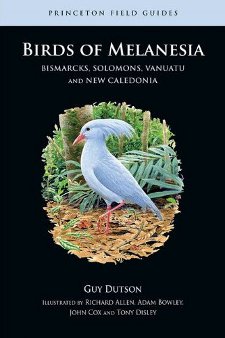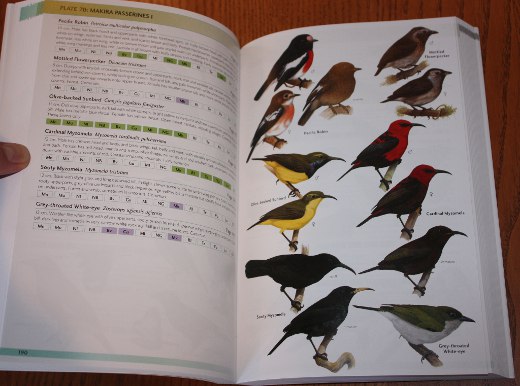Reviewed by Frank Lambert on March 19th, 2012.
“Island” Melanesia, the area covered by this excellent field guide, is one of those regions that are difficult to pinpoint on a map. It covers around 41,700 square miles and includes numerous islands, although dominated by the Bismarck Archipelago and New Caledonia. Birds of Melanesia: Bismarcks, Solomons, Vanuatu, and New Caledonia is the first guide to cover this interesting region, with 501 species, of which 377 are resident. 204 of these are endemic to this region including one endemic family (Rhynochetidae) with a single representative: the somewhat bizarre Kagu. The author, Guy Dutson, is one of the few experts on the birds of this fascinating region and has field experience with the vast majority of species covered.
Birds of the Solomons, Vanuata and New Caledonia (Dougherty et al. 1999 – Helm Field Guides) is the only comparable guide, but it only covered the 362 species found on those islands and is now dated. One thing to note is that Birds of Melanesia is an indispensible companion guide to Birds of New Guinea
(Beehler et al. 1986) since it covers the Papua New Guinea islands of New Britain, New Ireland, and Manus, which along with Bougainville are most often visited by birders as a side trip from mainland PNG. Birds of New Guinea, however, does not cover these island groups.
A series of maps clearly shows those areas that are included are the Admiralty, St Matthias, and Bismarck islands off New Guinea, the Solomon Islands including Bougainville (which belongs to PNG), Temotu (more often called Santa Cruz), Vanuatu, and New Caledonia. One odd thing about the maps, however, is that they do not show topography, which is both disappointing and inexplicable. With so many islands, the book includes a very useful five-page “gazetteer” that associates the 147 main island names with island groups and gives old or alternative names where appropriate (but no geographic coordinates). Introductory chapters provide useful information about each of the island groups, including a limited amount of information on some of the sites where some of the more interesting species can be seen. The introduction also provides basic information on vegetation and habitats, climate, and conservation issues. There is also a comprehensive checklist near the beginning of the book which many users will appreciate.
The layout is the typical Helm/Princeton format of text facing plates, these being the work of Richard Allen, Adam Bowley, John Cox, and Tony Disley. Illustrations are of a high standard. The illustration of Eastern Yellow Wagtail Motacilla tschutschensis simillima, however, is reproduced too darkly and shows it as having dark brown upperparts (should be olive). Some of the swiftlets seem too plump and short-winged, such as Uniform Swiftlet Aerodramus vanikorensis, which in life is a very slim, long-winged species. The tail streamers of the breeding Little Tern Sternula albifrons seem far too short – the migrant race here is sinensis, which has much longer streamers than other races (though I could not find out about the tail streamers of the rare and local resident form). But these are minor quibbles, and the great majority of the illustrations are excellent. With a relatively limited number of species on many of the islands, this guide should certainly enable the user to identify anything seen well.
The species texts are ordered taxonomically as are the non-passerine plates with a few exceptions where species are sensibly moved to plates that depict confusion species. Passerine plates, in contrast, are divided into groups of plates for each main island group – the Bismarcks, Solomons, Markira, Rennell, Temotu, Vanuatu, and New Caledonia – reflecting major biogeographic differences. As a result, some passerine species appear on more than one plate, though in some cases, such as with Collared Kingfisher Todiramphus chloris, the races on different islands are significantly different, and having the correct race(s) on a plate for a particular island group is very useful. The text opposite the plates is generally very brief, describing only the main identification features and different races where relevant, and includes nothing about vocalizations. Where distinctive races occur this is usually mentioned opposite the plates (though not in the checklist).
Instead of using distribution maps, this guide provides a distribution bar with boxes for 14 island groups and utilizing six different colors to indicate status in each part of its range. This arrangement undoubtedly saves a lot of space and in most cases works well. There are pitfalls to this method, however. For example, for Bismarck Black Myzomela one might get the impression that it can be seen on any small island off New Britain whereas it seems only to certainly occur on small islands to the west of this island (as noted in the main text). Also, for this species, it is unfortunate that a single very doubtful sight record for Kimbe Bay is mentioned, thus confounding even more the real distribution of a species that looks superficially very similar to Black Sunbird Leptocoma sericea (especially when bobbing around on a small boat offshore a small island!). All the distribution bars are tabulated over 14 pages in the checklist at the front.
The second half of the guide provides more comprehensive information on each species, including detailed descriptions, comparisons with similar species, voice, habits, conservation status, and range. The guide follows IOC names and taxonomy dating from early 2010, but also gives alternatives, as well as the French name and a local name for restricted-range species. The taxonomy is therefore fairly up to date, though I noticed that for some reason Markira Leaf Warbler Phylloscopus makirensis is included within Island Leaf Warbler P. poliocephalus, which is a relatively old arrangement (it is split on the latest IOC list). Since the book was published, Gray’s Locustella fasciolata and Sakhalin Grasshopper Warbler L. amnicola have been split, and it is not clear which of these almost identical-looking species has reached these islands.
Despite the perceived remoteness of Island Melanesia, 49 resident species are already of conservation concern and many more may be added in future years. The main problems that need to be addressed immediately are forest loss and the introduction of alien predators, but the effects of climate change on these islands may also prove to be very negative for species restricted to mountain tops. Three pigeons are believed to have already become extinct and another four species on New Caledonia are “probably extinct”. Two of these “probably extinct” species are nightbirds – New Caledonia Owlet-nightjar Aegotheles savesi and New Caledonia Nightjar Eurystopodus exul. It would seem to me rather premature to pronounce nocturnal species such as these “probably extinct” on such a large and poorly-worked island. My bet is that they are still there, waiting to be “rediscovered”. Something to bear in mind if you ever have an opportunity to visit this most fascinating of islands and use this marvelous Birds of Melanesia field guide. One of New Caledonia’s extant inhabitants, the Kagu, is in my top five birds list and unlikely to fall off it…
– Reviewed by Frank Lambert
This book has been co-published by Princeton University Press in the U.S. and Christopher Helm in the UK.
Disclosure: I get a small commission for purchases made through links in this post.






Comment